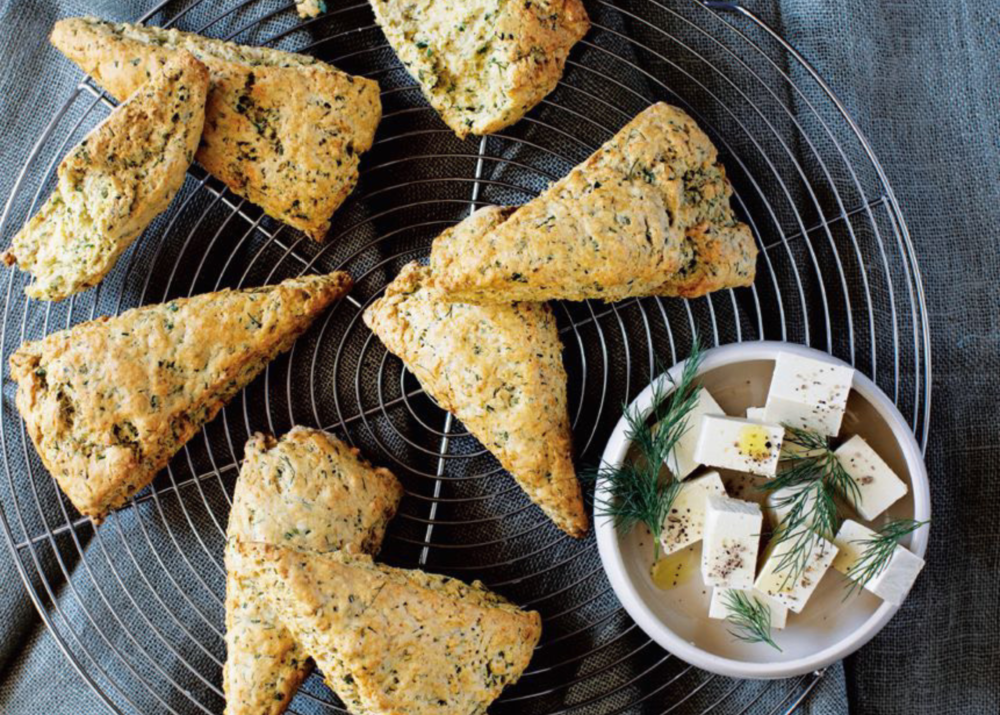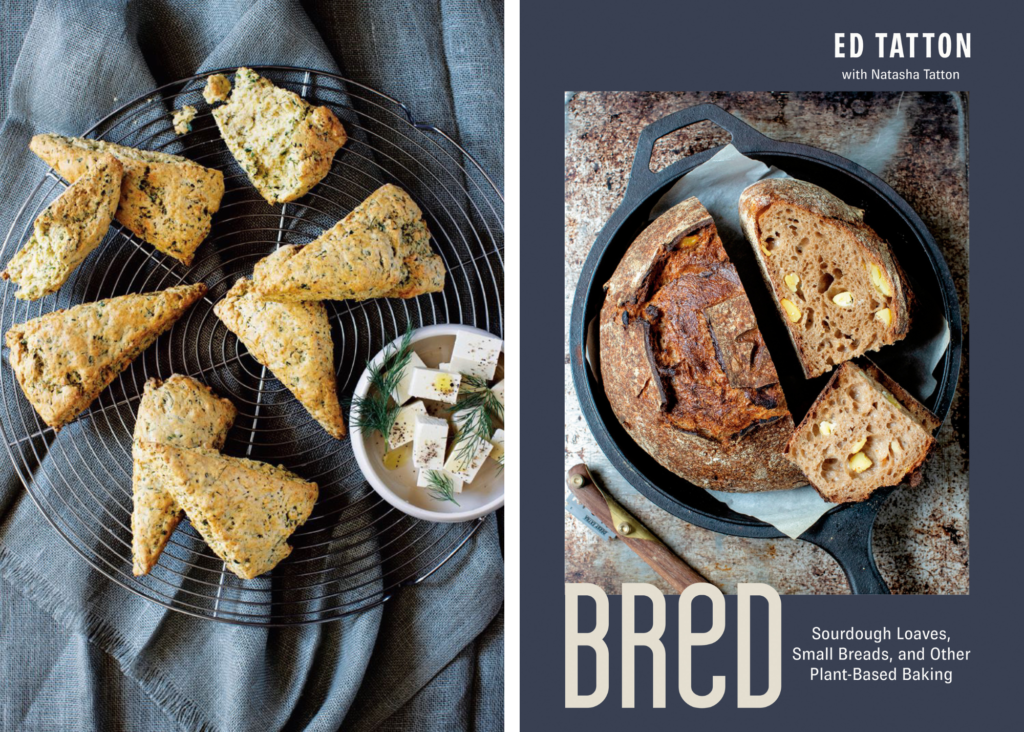
You have got to love the English language for its various dialects and cultural differences! Here is a case in point: a British biscuit is what North Americans call a cookie, but biscuits in North America are more like British scones. Is there a difference between an American biscuit and a British scone? A southern biscuit has more butter and acidity from buttermilk, making them flakier and fluffier, while scones rely on richer ingredients, like cream and eggs, to get a sturdy yet crumbly texture. Given that I am vegan, so do not use any dairy or eggs, this recipe is a cross between a biscuit and a scone. Call it as you please!
I’ve used my Macadamia Feta in this recipe to add a delicious creamy flavour and wonderful softness to the scones. The feta brings the slight acidity you would get from buttermilk and works with the soy milk as an egg replacer. I love to add a few different herbs for their flavour, aroma, and appearance. These scones are best served warm or lightly toasted with some extra feta, sliced pickled onions, herbs, and arugula, or simply with some vegan butter.
Excerpted from BReD by Edward Tatton and Natasha Tatton. Copyright © 2023 Edward Tatton and
Natasha Tatton. Photography by Janis Nicolay. Published by Penguin, an imprint of Penguin Canada, a
division of Penguin Random House Canada Limited. Reproduced by arrangement with the Publisher. All rights reserved.

Macadamia Feta & Herb Scones
ED TATTON is a professional chef who has been to culinary college and worked in high-end kitchens in the UK, Australia, New Zealand as well as Canada, but now specialises in making organic naturally leavened sourdough, baking bread, pizza dough, and other small baked goods. These days, Ed’s food is compassionately 100% plant-based, a movement he is passionately excited to be part of and help grow for the benefit of people, the planet, and animals.
NATASHA TATTON is an English teacher turned bakery manager, animal rights advocate, and co-author of BReD. Natasha has taught English all over the world and ventured into various food and beverage roles, mainly in bakeries, nurturing her desire to provide more compassionate food choices for people.
Ingredients
Macadamia Feta
I developed this vegan feta to recreate the crumbly, rich, and creamy textures and flavours of sheep and goat feta cheese using macadamia nuts. Macadamia feta can be used in lots of recipes. It’s especially good in my Macadamia Feta and Herb Scones (page 205), or enjoyed on pizzas, salads, and pastas. The process takes at least four days, so plan accordingly.
Feta
- 150g (1¼ cups) natural macadamia nuts 550g
- (2¼ cups) filtered water, divided
- Zest of 2 lemons
- 50g (¼ cup) lemon juice
- 5g garlic (2 cloves)
- 20g (3½ tablespoons) nutritional yeast
- 2.5g (½ teaspoon) fine sea salt
- 5g (2 tablespoons) agar-agar flakes or powder
Brine
- 1kg (4¼ cups) filtered water
- 50g (¼ cup) fine sea salt
Scones
- 110g (½ cup) cold vegan butter
- 400g (2½ cups) all-purpose flour
- 40g (2 tablespoons + 2¼ teaspoons) baking powder
- 50g (1/3 cup) stone-ground whole-grain spelt flour
- 25g (½ cup) nutritional yeast
- 5g (1 teaspoon) fine sea salt
- 2.5g (½ teaspoon) cracked black pepper
- 250g (1 cup) unsweetened soy milk
- 200g (1¾ cups) Macadamia Feta, cut into ¼-inch (5mm) cubes
- 50g (2/3 cup) finely chopped fresh herbs (such as dill, parsley, and chives)
Glaze
- 20g (1 tablespoon + 2 teaspoons) unsweetened soy milk
- 5g (1 teaspoon) pure maple syrup
- 2.5g (½ teaspoon) olive oil
Directions
Prepare the feta
- Place the macadamia nuts in a 1L (4-cup) glass jar or other Add 300g (1¼ cups) of the filtered water. Cover and let soak in the fridge overnight.
- The next morning, prepare a rectangular plastic or glass container with a lid, approximately 5½ × 3½ × 1½ inches (14 × 9 × 4cm) to set the feta in. Lightly spray or wipe the inside with extra-virgin olive oil, then line it with a sheet of plastic wrap, pressing into all the corners and stretching out as many creases as possible.
- Drain the nuts and transfer to a high-speed Add the remaining 250g (1 cup) filtered water, lemon zest, lemon juice, garlic, nutritional yeast, and salt. Blend on low speed for 30 seconds, then slowly increase to high speed, blending until the creamy mixture is smooth and beginning to heat, 2 to 3 minutes.
- Add the agar-agar. Blend, starting on low speed and slowly increasing to high, for about 4 minutes to activate the setting properties of the agar-agar. The cream will be very hot. Pour the cream mixture into the prepared container and let cool for 15 minutes. Cover the container with the lid and place in the fridge to set overnight.
Meanwhile, prepare the brine
- In a medium saucepan, bring the 1kg (4¼ cups) filtered water to a boil, then add the Remove from the heat and set aside to cool. Pour the cooled brine into a container large enough to fit the slab of feta, cover, and set aside in the fridge overnight.
Brine the feta
- The next morning, remove the feta from the Using the plastic wrap as handles, gently lift the set feta from the container and transfer it to the chilled brine container (ensuring that the feta is submerged in the brine). Cover and return to the fridge for at least 2 days and up to 5 days, depending how firm or salty you like your feta.
- Once the feta is brined to your liking, gently remove it from the brine (discarding the brine) and store it in an airtight container in the fridge for up to 10 days.
Make the scones
- Cut the butter into ¼-inch (5mm) cubes and freeze until needed.
- Preheat the oven to 350°F (175°C). Line a large baking sheet with parchment paper or a silicone baking.
- Sift together the all-purpose flour and baking powder into a large Add the spelt flour, nutritional yeast, salt, and pepper and whisk everything together.
- Add the frozen Using your fingertips, rub the butter into the flour until the mixture looks like bread- crumbs. Add the soy milk, macadamia feta, and chopped herbs. Using one hand while the other hand holds the bowl still, gently incorporate everything together just until a soft dough forms and no dry patches remain. Do not overmix.
- Lightly flour the work surface and the Roll out the dough into a rectangle ¾ to 1 inch (2 to 2.5cm) thick. Using a large chef’s knife, cut the dough crosswise into 4 rectangles, then cut each rectangle diagonally to make 8 equal-size triangles. Arrange them upside down on the lined baking sheet, leaving a little space between them to allow for growth and even baking. (The side that was on the work surface becomes the top, which helps with the rise and a nicer finished appearance.)
Glaze and bake
- In a small bowl, stir together the soy milk, maple syrup, and olive Using a pastry brush, lightly brush the tops of the scones a couple of times.
- Bake until the tops are golden brown, 15 to 17 minutes. Transfer the scones to a cooling rack to cool for at least 10 minutes before serving.
- Store in an airtight container in the fridge for up to 3 days. Lightly toast before serving.

